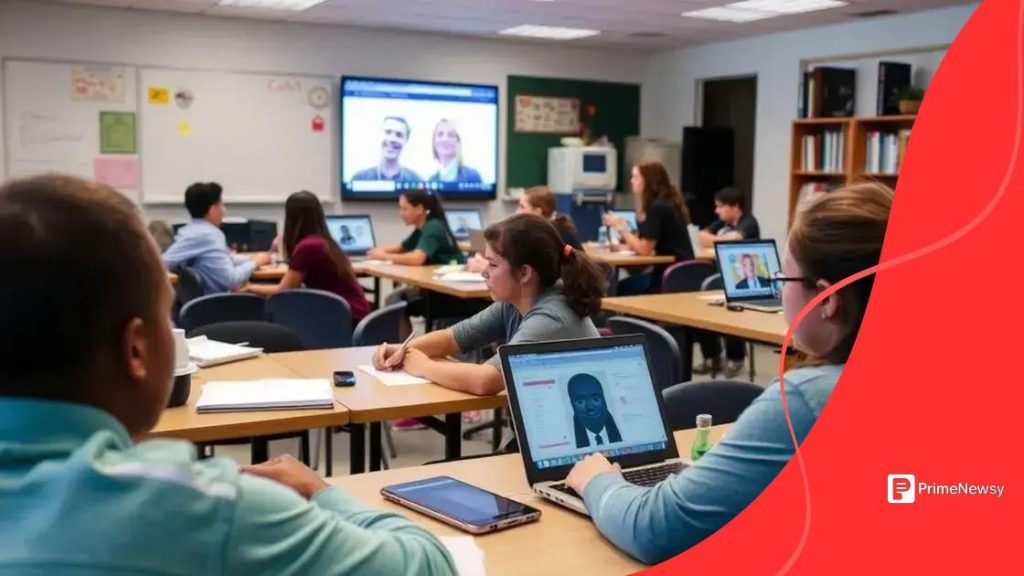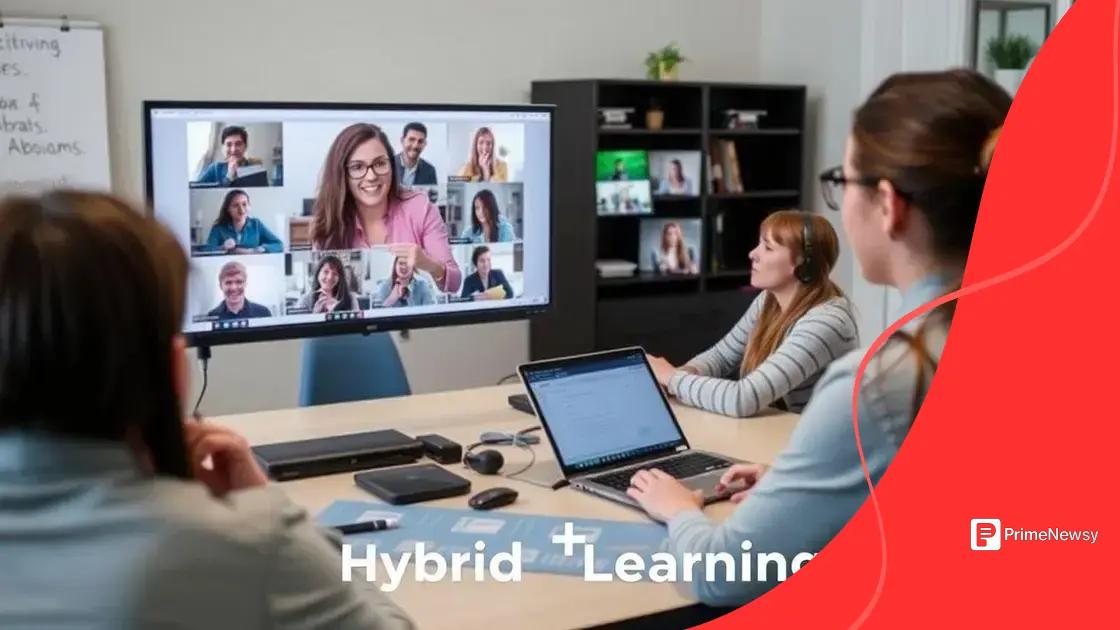Hybrid learning standards: transforming education for all

Anúncios
Hybrid learning standards combine in-person and online instruction to enhance flexibility, engagement, and personalized learning experiences, while presenting challenges such as technical issues and the need for effective teacher training.
Hybrid learning standards are reshaping education, blending in-person and online elements to enhance learning experiences. Have you ever wondered how these standards can improve engagement in the classroom? Let’s dive into the details.
Anúncios
Understanding hybrid learning
Understanding hybrid learning is vital for today’s education landscape. This approach combines traditional in-person instruction with online learning experiences, providing flexibility and accessibility. As technology evolves, understanding how to navigate these dynamics becomes essential for educators and students alike.
What is Hybrid Learning?
Hybrid learning integrates both in-person and remote learning methods. Schools may offer classes where students can choose between attending physically or engaging online. This blend caters to diverse learning styles and needs, making education more inclusive.
Key Characteristics of Hybrid Learning
- Flexibility: Students can learn at their own pace and choose their preferred environment.
- Engagement: Interactive tools and technologies enhance the learning experience.
- Accessibility: It allows for education to reach a wider audience, accommodating those with different schedules or locations.
- Personalization: Educators can tailor lessons to meet individual student needs.
Implementing hybrid learning standards requires careful planning. Educators must align learning objectives, choose appropriate technologies, and prepare materials that support both in-class and online learners. Communication is key to ensuring all students feel included, regardless of their learning mode.
Anúncios
In a hybrid learning environment, teachers can utilize various tools, such as learning management systems, video conferencing software, and collaborative platforms. These tools allow for real-time interaction, providing an engaging experience for students regardless of how they participate.
Key benefits of hybrid learning standards
Key benefits of hybrid learning standards provide educators with powerful tools to enhance education. These standards offer a mix of face-to-face and online learning, allowing students to enjoy the best of both worlds. This approach is becoming increasingly popular due to its many advantages.
Enhanced Flexibility
One of the significant benefits is flexibility in learning schedules. Students can choose when and how they learn best, whether attending classroom sessions or participating remotely. This flexibility supports various learning styles, making education more accessible to everyone.
Increased Engagement
Hybrid learning can lead to higher levels of student engagement. By integrating technology, teachers can use interactive tools that captivate students’ attention. Engaged learners are more likely to absorb information and participate in discussions.
- Utilization of multimedia resources helps maintain attention.
- Real-time feedback encourages improvement.
- Variety in lesson delivery keeps students interested.
- Collaborative projects enhance peer interaction.
This varied approach to learning also fosters a sense of community among students. Even when learning remotely, students can connect with peers through online forums and group projects.
Personalized Learning Experience
Another key benefit is the ability to personalize education. With hybrid learning, educators can tailor instruction to meet individual student needs. Some students may thrive in a classroom setting, while others might excel in an online environment.
With adaptive learning technologies, students receive targeted content based on their performance. This approach not only enhances understanding but also boosts confidence in learners.
How to implement hybrid learning strategies

How to implement hybrid learning strategies effectively can be a game changer for educators. This approach combines the best of in-person and online education, making learning more adaptable and engaging. Implementing these strategies requires planning and a clear understanding of both pedagogical goals and the needs of students.
Assessing Needs and Resources
Before diving into hybrid learning, it’s crucial to assess your needs. Understanding your classroom dynamics is the first step. Gather input from students and parents to find out what works best for them. Resources like technology, space, and time management also need consideration.
Choosing the Right Technology
Technology plays a key role in hybrid learning. Selecting the right tools makes a big difference. Some popular platforms include:
- Learning Management Systems (LMS) for organizing and sharing resources.
- Video conferencing tools for live classes and discussions.
- Interactive software for quizzes and group activities.
- Collaboration tools that enable group projects and discussions.
These technologies allow seamless interaction between online and in-person students. When students feel included, their engagement rises, leading to better learning outcomes.
Creating a Flexible Curriculum
Your curriculum should reflect the hybrid model. Start by developing a flexible syllabus that accommodates both types of learners. Ensure that materials are accessible for all students, whether they are learning in person or online. Create opportunities for collaboration among students in different settings and encourage peer-to-peer learning.
Regular check-ins help maintain a connection with students, ensuring they are staying on track. Adapting lessons based on student feedback can significantly improve the learning experience.
Challenges in adopting hybrid learning standards
Challenges in adopting hybrid learning standards can impact the effectiveness of educational programs. As schools transition to mixed learning environments, several obstacles may arise that educators need to address. Understanding these challenges is critical for successful implementation.
Technical Issues
One major hurdle is dealing with technical issues. Schools must ensure that all students have access to the necessary devices and reliable internet connections. Any disruptions in technology can hinder learning and cause frustrations among students and educators alike.
Training and Support
Another challenge is the need for adequate training and support for teachers. Many educators may not be familiar with hybrid teaching strategies. Without proper training, they may struggle to integrate technology effectively into their lessons.
- Professional development programs can help teachers adapt.
- Ongoing support and resources are crucial for success.
- Collaboration among teachers can enhance shared knowledge of best practices.
Furthermore, students also require guidance on how to navigate hybrid learning models. Orienting them and providing resources boosts their confidence and engagement in the learning process.
Balancing Student Needs
Meeting the diverse needs of students in a hybrid classroom presents another challenge. Teachers must find ways to engage both in-person and online learners equally. This can be tricky, as students in different learning environments may have varying levels of participation and focus.
Creating inclusive activities that cater to both groups helps maintain engagement. Equally important is encouraging communication and collaboration between students, regardless of their learning mode. Building a classroom community is essential to overcoming obstacles.
Future trends in hybrid learning
Future trends in hybrid learning are shaping the way we think about education. As technology advances, hybrid learning models are evolving to meet the needs of students and educators. These trends will significantly influence how learning environments are structured in the coming years.
Increased Use of Technology
One major trend is the increased use of technology. Schools are integrating more sophisticated tools to enhance the learning experience. Virtual reality (VR) and augmented reality (AR) will become more common, allowing students to explore concepts in immersive ways.
Personalized Learning Experiences
Another trend is the move towards personalized learning experiences. With data analytics, educators can tailor educational content to meet the specific needs of individual students. This approach ensures that every learner progresses at their own pace, receiving support when needed.
- Adaptive platforms can modify lessons based on student performance.
- Customized assessments provide insights into student understanding.
- Feedback loops allow for immediate adjustments to teaching methods.
Moreover, hybrid learning will likely expand into new subjects and skills, such as digital literacy and critical thinking. These areas are essential for preparing students for a constantly changing workforce.
Flexible Learning Environments
Flexible learning environments will also play a crucial role. Schools may adopt more fluid classroom designs, blending physical and online spaces seamlessly. This flexibility allows for better collaboration among students, regardless of where they are learning.
Teachers will become facilitators rather than traditional instructors, encouraging students to take control of their own learning. This shift can foster independence and a deeper understanding of the material.
FAQ – Frequently Asked Questions about Hybrid Learning Standards
What are the main benefits of hybrid learning standards?
Hybrid learning standards provide flexibility, enhance engagement, and allow for personalized learning experiences for students.
What challenges might schools face when adopting hybrid learning?
Schools may encounter technical issues, the need for teacher training, and finding ways to balance online and in-person student needs.
How can technology improve hybrid learning?
Technology, such as interactive tools and learning platforms, can facilitate real-time communication and collaboration between students, whether they are online or in-person.
What future trends can we expect in hybrid learning?
In the future, we can anticipate increased use of advanced technology like VR and AR, alongside more personalized and flexible learning environments.